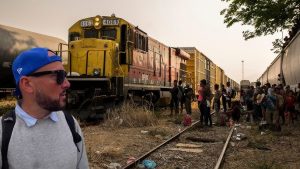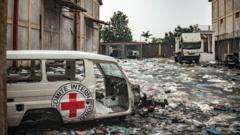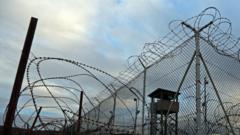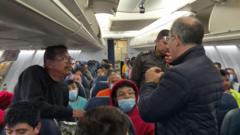The harrowing experiences of migrants riding “The Beast” elucidate the dangers of seeking better lives, prompting both regional policy changes and human rights concerns.
Migrants Risk It All on "The Beast" as Dangers Escalate

Migrants Risk It All on "The Beast" as Dangers Escalate
Desperate journeys through Mexico lead migrants to perilous freight train rides.
Migrants traveling through Mexico toward the United States face severe dangers, particularly when they choose to board the infamous freight train known as “The Beast” or "La Bestia." Initially designed for cargo, this train has become synonymous with peril, as thousands of Central American and Venezuelan migrants embark on this treacherous journey, fully aware that one miscalculated step could result in catastrophic consequences.
Riding atop “The Beast” is fraught with risks. Migrants precariously cling to railcars, often trapped in overcrowded conditions, leading to fatal accidents and violent episodes. A security expert recounted harrowing tales to the New York Post, noting the extreme hazards that accompany the overcrowding. Illustratively horrifying, he mentioned the chilling incident captured on video, in which a migrant was tragically severed after falling from the train. Recent estimates reveal that around 500,000 people challenge their fate on these “death trains” annually, illustrating the desperation that fuels these dangerous migrations.
The surge in migration has been exacerbated by upcoming immigration reforms promised by President-elect Donald Trump. As his inauguration approaches, locals near rail stops, including Claudia Rios in Durango, observe a significant uptick in migration activities. Rios reported seeing groups exceeding 200 people, noting a shift in dynamics where the desperation manifests in aggressive behaviors. She recounted instances of children and individuals in wheelchairs striving to board, highlighting the dire circumstances that drive these individuals toward peril.
In response to the growing crisis, Texas Governor Greg Abbott has implemented an aggressive strategy. Following previous tactics, such as erecting razor wire barriers, Abbott's latest initiative features a provocative marketing campaign targeted at potential migrants. Billboards bearing stark, distressing messages, including "How much did you pay to have your daughter raped?” and “Coyotes lie. Don’t put your family at risk," have emerged across Mexico and Central America. Written in multiple languages, these messages aim to dissuade individuals from embarking on such dangerous undertakings. During a press conference in Eagle Pass, Abbott reiterated the objective behind this campaign, emphasizing the intention to discourage life-threatening migrations that could culminate in arrests and deportations.
Amid these challenges, human rights organizations like WOLA have voiced concerns over increasing violence against migrants. They cite a notable rise in kidnappings and extortion, suggesting that this era may represent one of the most violent periods in recent history for migrants. Furthermore, WOLA claims that many Mexican officials may either turn a blind eye or actively participate in these brutalities, compounding the perils faced by migrants.
From the precarious journey atop “The Beast” to the grim cautions emblazoned on billboards, the migrant crisis significantly reflects the harsh realities of human desperation and survival. As migration policies evolve and the human costs escalate, these narratives challenge us to consider critically the broader implications of migration in our ever-changing world.





















